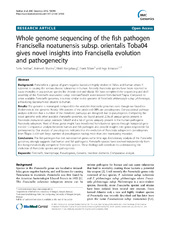Whole genome sequencing of the fish pathogen Francisella noatunensis subsp. orientalis Toba04 gives novel insights into Francisella evolution and pathogenecity
Peer reviewed, Journal article
Peer reviewed

Permanent lenke
https://hdl.handle.net/1956/8516Utgivelsesdato
2012-11-06Metadata
Vis full innførselSamlinger
Originalversjon
https://doi.org/10.1186/1471-2164-13-598Sammendrag
Background: Francisella is a genus of gram-negative bacterium highly virulent in fishes and human where F. tularensis is causing the serious disease tularaemia in human. Recently Francisella species have been reported to cause mortality in aquaculture species like Atlantic cod and tilapia. We have completed the sequencing and draft assembly of the Francisella noatunensis subsp. orientalisToba04 strain isolated from farmed Tilapia. Compared to other available Francisella genomes, it is most similar to the genome of Francisella philomiragia subsp. philomiragia, a free-living bacterium not virulent to human. Results: The genome is rearranged compared to the available Francisella genomes even though we found no IS-elements in the genome. Nearly 16% percent of the predicted ORFs are pseudogenes. Computational pathway analysis indicates that a number of the metabolic pathways are disrupted due to pseudogenes. Comparing the novel genome with other available Francisella genomes, we found around 2.5% of unique genes present in Francisella noatunensis subsp. orientalis Toba04 and a list of genes uniquely present in the human-pathogenic Francisella subspecies. Most of these genes might have transferred from bacterial species through horizontal gene transfer. Comparative analysis between human and fish pathogen also provide insights into genes responsible for pathogenecity. Our analysis of pseudogenes indicates that the evolution of Francisella subspecies’s pseudogenes from Tilapia is old with large number of pseudogenes having more than one inactivating mutation. Conclusions: The fish pathogen has lost non-essential genes some time ago. Evolutionary analysis of the Francisella genomes, strongly suggests that human and fish pathogenic Francisella species have evolved independently from free-living metabolically competent Francisella species. These findings will contribute to understanding the evolution of Francisella species and pathogenesis.
Utgiver
BioMed CentralTidsskrift
BMC GenomicsOpphavsrett
Settu Sridhar et al.; licensee BioMed Central Ltd.Copyright 2012 Sridhar et al.; licensee BioMed Central Ltd.
